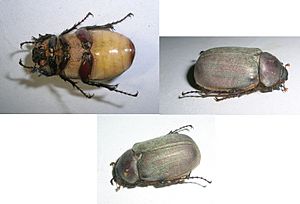Holotrichia facts for kids
Quick facts for kids Holotrichia |
|
|---|---|
 |
|
| Holotrichia species (possibly H. reynaudi) | |
| Scientific classification |
|
| Kingdom: | Animalia |
| Phylum: | Arthropoda |
| Class: | Insecta |
| Order: | Coleoptera |
| Family: | Scarabaeidae |
| Subfamily: | Melolonthinae |
| Tribe: | Melolonthini |
| Genus: | Holotrichia Hope, 1837 |
| Species | |
|
Many species |
|
Holotrichia is a group of beetles. They belong to a large family called Scarabaeidae. Many people know these beetles as "chafer beetles." Their young, which are called larvae, are often known as "white-grubs." These white-grubs live underground. They eat the roots of plants.
Contents
Understanding Holotrichia Beetles
What are Chafer Beetles?
Holotrichia beetles are a type of beetle. They are part of the Scarabaeidae family. This family includes many well-known beetles. Some examples are dung beetles and June bugs. Holotrichia beetles are often called "chafer beetles." This name comes from their appearance and habits.
Life Cycle and Habits
The life of a Holotrichia beetle starts as an egg. The eggs hatch into larvae. These larvae are the "white-grubs" you might hear about. They are white and C-shaped. White-grubs live in the soil. They spend their time eating the roots of plants. This feeding helps them grow. After growing enough, they change into pupae. Finally, they become adult beetles. The adult beetles fly around. They mate and lay eggs. This cycle then starts all over again.
Why are they Pests?
Some Holotrichia species can cause problems. They are known as pests in farming. For example, Holotrichia serrata can harm sugarcane crops. Another species, Holotrichia consanguinea, causes issues for groundnut (peanut) plants. The main damage comes from the white-grubs. When they eat plant roots, they make the plants weak. This can lead to plants not growing well. Sometimes, the plants can even die. Farmers work to protect their crops from these grubs.

